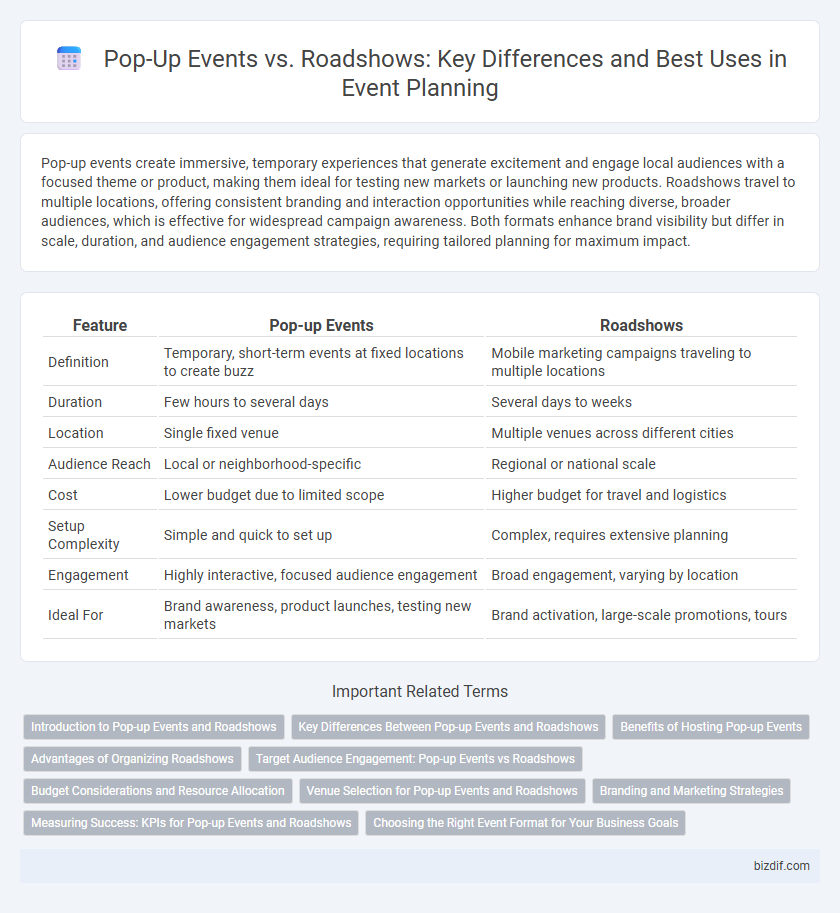Pop-up events create immersive, temporary experiences that generate excitement and engage local audiences with a focused theme or product, making them ideal for testing new markets or launching new products. Roadshows travel to multiple locations, offering consistent branding and interaction opportunities while reaching diverse, broader audiences, which is effective for widespread campaign awareness. Both formats enhance brand visibility but differ in scale, duration, and audience engagement strategies, requiring tailored planning for maximum impact.
Table of Comparison
| Feature | Pop-up Events | Roadshows |
|---|---|---|
| Definition | Temporary, short-term events at fixed locations to create buzz | Mobile marketing campaigns traveling to multiple locations |
| Duration | Few hours to several days | Several days to weeks |
| Location | Single fixed venue | Multiple venues across different cities |
| Audience Reach | Local or neighborhood-specific | Regional or national scale |
| Cost | Lower budget due to limited scope | Higher budget for travel and logistics |
| Setup Complexity | Simple and quick to set up | Complex, requires extensive planning |
| Engagement | Highly interactive, focused audience engagement | Broad engagement, varying by location |
| Ideal For | Brand awareness, product launches, testing new markets | Brand activation, large-scale promotions, tours |
Introduction to Pop-up Events and Roadshows
Pop-up events are temporary, immersive experiences designed to create buzz and engage customers in a specific location for a short period. Roadshows involve traveling presentations or exhibitions that visit multiple locations to reach a broader audience and provide consistent brand messaging across regions. Both formats offer unique opportunities for direct interaction, brand exposure, and targeted marketing strategies.
Key Differences Between Pop-up Events and Roadshows
Pop-up events are temporary, location-specific activations designed to create immediate, immersive brand experiences, often lasting a few hours to days. Roadshows involve a series of scheduled stops across multiple locations, targeting broader audience engagement over an extended period with consistent messaging. Key differences include duration, geographic reach, and logistical complexity, with pop-ups emphasizing short-term impact while roadshows focus on sustained brand presence and market penetration.
Benefits of Hosting Pop-up Events
Pop-up events offer flexible and cost-effective opportunities for brands to create immersive, temporary experiences that drive immediate consumer engagement and boost local market presence. These events generate buzz through exclusivity and limited-time offers, fostering stronger emotional connections and encouraging social media sharing. Hosting pop-up events enhances brand visibility and allows real-time feedback collection, enabling agile marketing strategies tailored to specific audiences.
Advantages of Organizing Roadshows
Roadshows offer the advantage of reaching broader and diverse audiences by traveling to multiple locations, enhancing brand visibility and engagement across regions. They provide immersive, interactive experiences that foster stronger customer connections and real-time feedback. Organizers benefit from extended exposure time and the ability to adapt presentations to various demographics, maximizing marketing impact.
Target Audience Engagement: Pop-up Events vs Roadshows
Pop-up events create exclusive, immersive experiences that drive high engagement through their temporary and targeted nature, making them ideal for attracting niche or local audiences. Roadshows offer broad reach and repeated brand exposure by touring multiple locations, effectively engaging diverse demographics over time. Brands choose pop-ups for deep, personalized interactions and roadshows for sustained, widespread audience engagement across regions.
Budget Considerations and Resource Allocation
Pop-up events typically require lower budgets due to their short duration and limited setup, enabling efficient resource allocation with minimal staffing and materials. Roadshows demand higher financial investment for extensive logistics, including transportation, multiple venue arrangements, and sustained marketing efforts across different locations. Strategic budgeting for roadshows must account for travel costs, accommodation, and consistent brand presentation, while pop-ups prioritize flexibility and cost-effective execution.
Venue Selection for Pop-up Events and Roadshows
Venue selection for pop-up events prioritizes high-traffic, accessible locations such as shopping malls, streets, or plazas to maximize brand visibility and spontaneous engagement. Roadshows require versatile venues like convention centers, community halls, or outdoor spaces that accommodate larger crowds and dynamic setups for interactive presentations. Both strategies demand careful consideration of target audience demographics, logistical feasibility, and local regulations to ensure successful execution.
Branding and Marketing Strategies
Pop-up events create exclusive, short-term brand experiences that generate buzz and drive immediate consumer engagement through unique, localized marketing efforts. Roadshows offer broader geographic reach, allowing brands to build sustained awareness and interaction by traveling to multiple markets with consistent messaging and experiential activations. Both formats leverage immersive storytelling and direct customer interaction, but pop-ups prioritize intensity and exclusivity, while roadshows emphasize scale and repeated brand exposure.
Measuring Success: KPIs for Pop-up Events and Roadshows
Key performance indicators (KPIs) for measuring success in pop-up events include foot traffic, dwell time, social media engagement, and on-site sales conversion rates, which provide direct insights into customer interaction and brand impact. Roadshows prioritize metrics such as event attendance, lead generation quality, audience demographics, and post-event follow-up engagement to evaluate their broader market reach and brand awareness effectiveness. Both event types value data on customer feedback and return on investment to refine future marketing strategies and enhance experiential outcomes.
Choosing the Right Event Format for Your Business Goals
Pop-up events offer immersive, short-term brand experiences ideal for generating immediate customer engagement and testing new markets, while roadshows provide extended reach through multiple locations, enhancing brand visibility and customer interaction over time. Selecting the right event format hinges on your business objectives, budget constraints, target audience demographics, and desired ROI. Aligning event scale with marketing strategy ensures maximum impact and efficient resource allocation in meeting sales or awareness targets.
Pop-up events vs Roadshows Infographic

 bizdif.com
bizdif.com